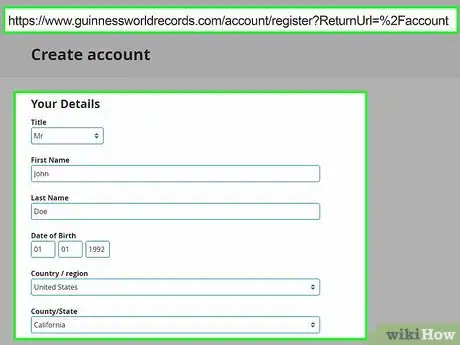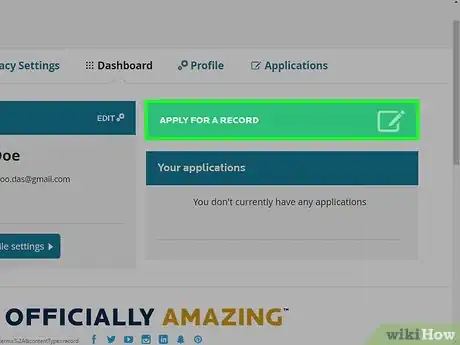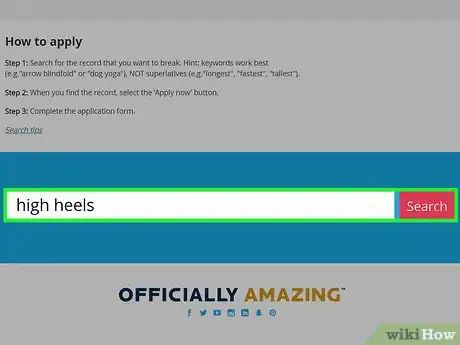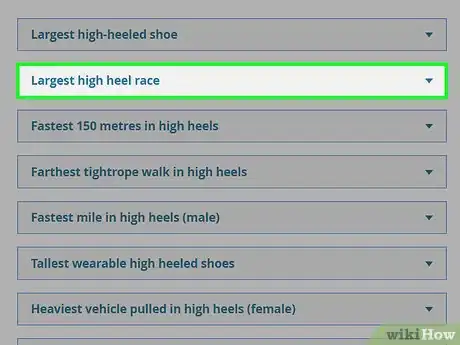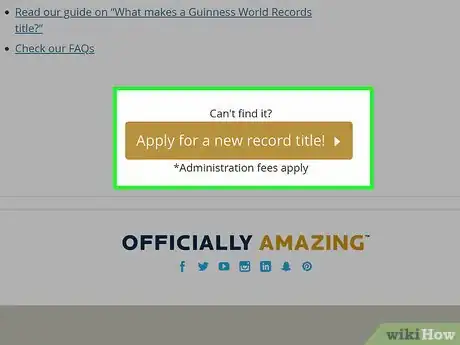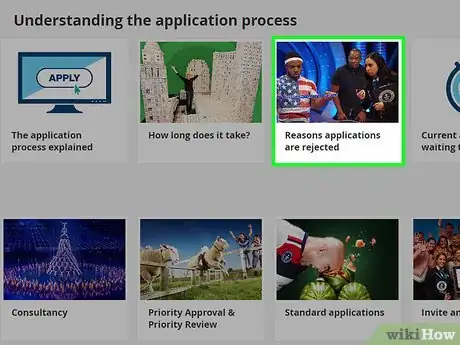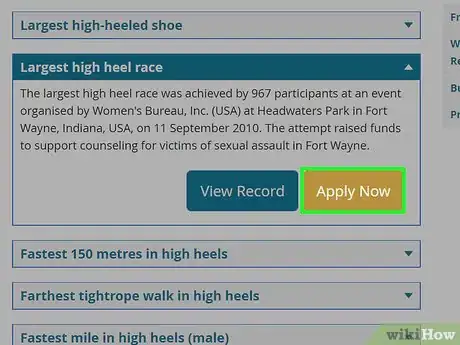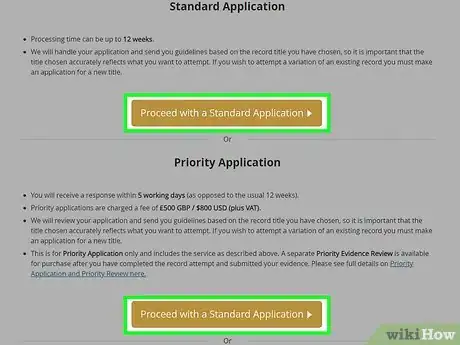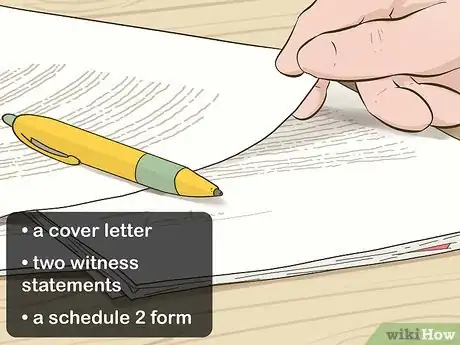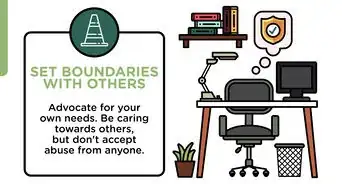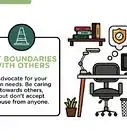This article was co-authored by wikiHow staff writer, Kyle Hall. Kyle Hall works on the content team at wikiHow. He helps manage our team of editors and creates content for a variety of wikiHow projects. Kyle continually looks for new ways to improve the content at wikiHow and make it more helpful and enjoyable for readers. He graduated from Eckerd College in 2015, where he majored in Political Science.
There are 7 references cited in this article, which can be found at the bottom of the page.
wikiHow marks an article as reader-approved once it receives enough positive feedback. In this case, several readers have written to tell us that this article was helpful to them, earning it our reader-approved status.
This article has been viewed 312,493 times.
Learn more...
Guinness World Records is an organization that recognizes record achievements across the globe. Before you submit your application for a potential record, you’ll need to make sure your record meets certain standards and get registered on the official Guinness World Records website. Once you submit the application and necessary paperwork, you can eagerly wait to find out if you’re an official world record holder.
Things You Should Know
- Make an account on the Guinness World Records website, follow their formatting criteria, and ensure you also meet the minimum requirement for a new record.
- Break a measurable, universally understandable, objective, and challenging record; ensure your record can be proven as well.
- Fill out and submit an application; if accepted, provide the necessary evidence of your record for Guinness World Records to review.
Steps
Getting Started on the Website
-
1Register for an account on the Guinness World Records website. Visit https://www.guinnessworldrecords.com/account/register?ReturnUrl=%2Faccount to register. Enter your title, name, date of birth, county, country, and email. You’ll also be prompted to create a password.[1]
- Write down the password you make somewhere so you don’t forget it later on.
-
2Check your email inbox for an activation link. The email will be from the address “noreply@guinnessworldrecords.com.” Open the email and click on the activation link inside. You’ll be brought to your personal dashboard on the Guinness World Records website.
- If you don't receive the email right away, check your spam folder. If you use multiple email accounts, make sure that you are logged into the one you signed up with.
Advertisement -
3Click on the green “apply for a record” button on the middle of the page. You’ll be brought to the record application search page. The page allows you to search through a catalog of records that you can break.[2]
-
4Search for the record you’re applying for. Type in a key word into the search bar, then click the red “search” button. Use actual key words and not superlatives. For example, if you’re trying to break the record for walking down a runway in the highest high heels, search for “high heels” instead of “highest.”[3]
- If your record spans multiple topics, like high heels and walking, start with the more detailed one. In this case, it would be "high heels."
-
5Scroll through the list of breakable records and choose the one you want. Click on the blue “view record” button next to a record to see what the current record is that you’d have to break. Click the yellow “apply now” button when you’re ready to choose a record.[4]
-
6Meet the minimum requirement if you’re applying for a new record title. New record titles are records that have not yet been recognized by Guinness World Records. If you submit a new record title that meets all of the Guinness World Records standards and formatting criteria, they will establish a minimum, based on their research, that you must beat to officially have broken the new record.
- For example, if you’re applying to break the record for the longest amount of time spent in a VR headset, Guinness World Records may do some research and say that 20 hours is an appropriate benchmark. You'll have to beat that to claim the world record.
-
7Avoid records that don’t meet the Guinness World Records formatting criteria. Every type of record, whether it has to do with food or art or extreme sports, has a specific format that needs to be followed. Guinness World Records will only accept records that follow the proper formatting.
- For example, the record of most food served in X amount of time is formatted so that X can be 1 hour, 8 hours, 12 hours, or 24 hours. Therefore, if you submitted an application for the record of serving the most food in 15 hours, you wouldn’t be following the formatting criteria and your application would be rejected.
Breaking or Setting a Record
-
1Break a record that is measurable. Being the tallest person on Earth, eating the most hot dogs, and running the fastest mile are all records that can be measured.[5] Things that are abstract or based on opinion are not measurable.
- For example, being the world's "greatest cat lover" is abstract. However, "owning the world's most cat figurines" is measurable.
-
2Break a record that is universally understandable. For example, being the fastest swimmer in the world would work as a record because most people in the world understand what swimming is.[6]
-
3Make sure your record can be broken. If other people can’t repeat your record and attempt to beat you, your record will not be accepted.[7]
-
4Make sure your record is verifiable. You have to be able to prove that you actually broke a record. Claiming that you ate 700 marshmallows in ten minutes when you were younger isn’t something that can be verified (unless you have it on tape).[8]
- You'll need two witnesses (not related to you) to sign off on a form saying you successfully broke the record you attempted. Keep that in mind if you're attempting a record that is hard to replicate.
-
5Break a record that is adequately challenging. Guinness World Records doesn’t recognize every achievement, just those that are universally challenging. You won’t get a record for leaving your TV on for 2 years straight (even if that’s the longest anyone’s left their TV on for) because you didn’t actually have to do anything that challenging.[9]
-
6Make sure your record is objective. You can’t break a record for being the coolest person in the world or having the best sounding voice. Only records that are objective and measurable will be accepted.[10]
-
7Never attempt a record that is harmful to bystanders or animals. If you’re putting the lives of people or animals in danger when attempting your record, your application will be rejected.[11]
Submitting the Application
-
1Fill out the application for the record you’ve chosen. Enter the date you broke the record and the city, county, and country you broke it in. Add a detailed description of how and where you broke the record, and choose from the drop-down menu what your purpose for breaking the record was.
- Depending on your record, you may be prompted to enter in a measurement. For example, if you broke the record for owning the largest doll collection, you’d need to enter how many dolls you own into the measurement field.
-
2Submit your application as standard or priority. You’ll be prompted to select standard or priority on the “choose an application option” page that comes up after you submit your application. A standard application is free and has a processing time of up to 12 weeks, meaning you could wait 12 weeks before you hear back from anyone. A priority application costs $800 USD (£500) and has a processing time of 5 working days. Click on the yellow “proceed” button below the option you’re interested in.
-
3Wait for Guinness World Records to review your application. If you submitted a standard application, you should hear back about your record within 12 weeks. If you submitted the priority application, you should hear back within 5 working days. If your application is accepted, you’ll receive an email prompting you to download the “Guidelines and Evidence Requirements” from your Guinness World Records profile.[12]
-
4Submit the necessary evidence to prove you broke a record. Submit all of your evidence online through your Guinness World Records profile. The “Guidelines and Evidence Requirements” you downloaded on your profile will specifically lay out what you need to submit.[13] Different types of records require different forms of evidence, but all record attempts require:
- A cover letter: You’ll have to fill out the Guinness World Records cover letter form, explaining what record you broke and how you broke it.[14]
- Two witness statements: You must have two people, not related to you in any way, witness your record attempt. They each have to sign a witness statement and submit it with your evidence.[15]
- A schedule 2 form: By signing the schedule 2 form, you agree to release to Guinness World Records all of the evidence you’re submitting for your record attempt.[16]
-
5Wait to hear if your record attempt is approved. If your evidence is approved and your attempt at breaking a record is deemed a success, you’ll officially be a Guinness World Records record holder! As a record-holder, you will receive an official certificate from Guinness World Records featuring your name and the record you broke.[17]
References
- ↑ https://www.guinnessworldrecords.com/account/register?ReturnUrl=%2Faccount
- ↑ http://www.guinnessworldrecords.com/faq/
- ↑ https://www.guinnessworldrecords.com/records/the-application-process
- ↑ https://www.guinnessworldrecords.com/records/the-application-process
- ↑ http://www.guinnessworldrecords.com/records/what-makes-a-guinness-world-records-record-title/
- ↑ http://www.guinnessworldrecords.com/records/what-makes-a-guinness-world-records-record-title/
- ↑ http://www.guinnessworldrecords.com/records/what-makes-a-guinness-world-records-record-title/
- ↑ http://www.guinnessworldrecords.com/records/what-makes-a-guinness-world-records-record-title/
- ↑ http://www.guinnessworldrecords.com/records/what-makes-a-guinness-world-records-record-title/
- ↑ http://www.guinnessworldrecords.com/records/what-makes-a-guinness-world-records-record-title/
- ↑ http://www.guinnessworldrecords.com/records/what-makes-a-guinness-world-records-record-title/
- ↑ https://www.guinnessworldrecords.com/records/apply-to-set-or-break-a-record
- ↑ http://www.guinnessworldrecords.com/set-a-record/guides-templates/guide-to-evidence
- ↑ http://www.guinnessworldrecords.com/set-a-record/guides-templates/guide-to-evidence
- ↑ http://www.guinnessworldrecords.com/set-a-record/guides-templates/guide-to-evidence
- ↑ http://www.guinnessworldrecords.com/set-a-record/guides-templates/guide-to-evidence
- ↑ http://www.guinnessworldrecords.com/contact/application-enquiry
About This Article
To apply for a Guinness World Record, visit the organization's website and register for an account. Then, click on the green "Apply for a record" button, and locate the record you're applying for by typing its keyword into the search box. Once you've found the relevant record, provide the time and place where you broke the record, and give a description of how you did it. Next, choose between a standard or priority application before submitting your application form. Finally, submit your application and wait to hear from Guinness World Records. For tips on how to choose a record that's recognized by Guinness World Records, read on!
